When a child has severe psoriasis, ichthyosis, or another stubborn skin condition that doesn’t respond to creams or light therapy, doctors sometimes turn to acitretin. It’s not the first choice. It’s not even the second. But when nothing else works, and the skin is causing real pain, itching, or social distress, acitretin becomes a tool worth understanding - especially for parents who want to know: is it safe?
What is acitretin, really?
Acitretin is a synthetic retinoid, a man-made version of vitamin A. It’s not a steroid. It doesn’t suppress the immune system like some other drugs. Instead, it works by slowing down how fast skin cells grow and helping them shed normally. In kids with psoriasis, this means fewer thick, scaly patches. In those with congenital ichthyosis, it can make skin smoother and less cracked.
It’s sold under brand names like Neotigason and is taken by mouth as a capsule. The effects don’t show up overnight. Most kids need at least 6 to 8 weeks before any real improvement appears. Full results often take 3 to 6 months. That’s a long time to wait when your child is uncomfortable, but patience matters - and so does monitoring.
Why isn’t acitretin used more often in children?
Because it’s powerful - and carries risks. The biggest concern? Bone changes. Long-term use of acitretin in growing children has been linked to premature closing of growth plates, which can permanently affect height. Studies from the 1990s and early 2000s showed this risk clearly. One 2003 study of 47 children on acitretin for over a year found that 30% had measurable changes in bone density or growth plate fusion on X-rays.
Another issue is liver toxicity. Acitretin is processed by the liver. Kids with pre-existing liver conditions or those on other medications that stress the liver are at higher risk. That’s why doctors check liver enzymes before starting treatment and every 3 to 6 months after.
And then there’s the cholesterol problem. Acitretin raises triglycerides and LDL (the "bad" cholesterol) in about half of users. In adults, that’s manageable. In kids, especially those already overweight or with a family history of high cholesterol, it’s a red flag.
When do doctors actually prescribe it for kids?
Acitretin isn’t approved by the FDA for children under 12, but it’s used off-label in severe cases - and many pediatric dermatologists have done it for decades. It’s reserved for conditions that:
- Don’t respond to topical treatments (like calcipotriene or coal tar)
- Are unresponsive to phototherapy (UVB light)
- Are causing physical discomfort or emotional distress
- Have been confirmed by biopsy or specialist diagnosis
Common conditions include:
- Generalized pustular psoriasis
- Severe plaque psoriasis covering more than 20% of the body
- Autosomal recessive congenital ichthyosis (ARCI)
- Chronic palmoplantar pustulosis
In these cases, the benefits often outweigh the risks - but only if the treatment is tightly controlled. That means monthly blood tests, regular growth tracking, and no missed appointments.
What are the real side effects parents should watch for?
Not all side effects are obvious. Some are silent. Others are loud.
Common ones - and they’re common in about 1 in 3 kids:
- Dry lips, dry skin, peeling hands and feet
- Nosebleeds
- Itchy or red eyes
- Thinning hair or brittle nails
- Mild headaches
Less common but serious:
- Increased intracranial pressure (headaches, blurred vision, vomiting)
- Depression or mood swings
- Persistent high triglycerides (above 500 mg/dL)
- Abnormal liver enzymes (ALT or AST more than 3x normal)
One thing parents often overlook: sun sensitivity. Acitretin makes skin burn faster. Even a short walk in the sun can cause a bad sunburn. Daily sunscreen (SPF 50+), hats, and avoiding peak sun hours aren’t optional - they’re part of the treatment plan.
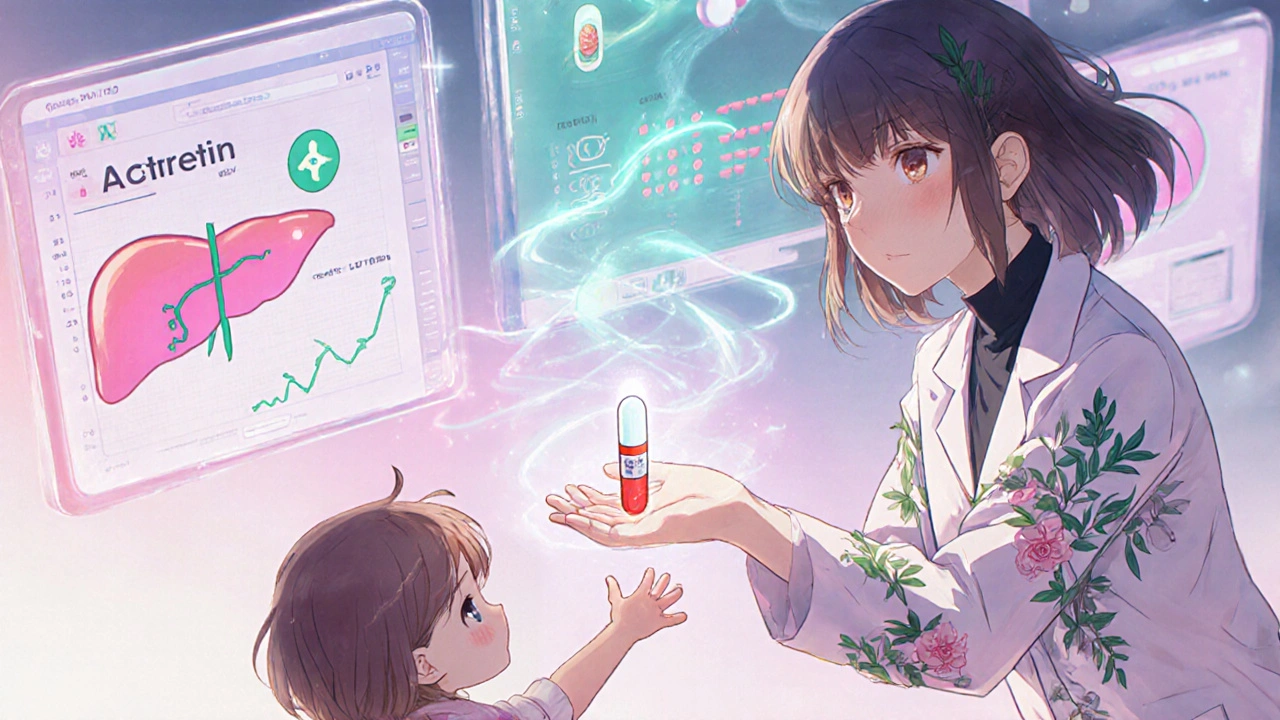
How do doctors minimize the risks?
Good doctors don’t just hand out a prescription. They build a safety net.
First, they start low. Most kids begin with 0.5 mg per kg of body weight per day - often around 10 to 25 mg total. That’s much lower than adult doses. They increase it slowly only if needed.
Second, they use it for the shortest time possible. Many kids get relief in 4 to 6 months and then stop. Some go on longer, but only if they’re monitored closely. If growth slows or liver enzymes rise, they stop immediately.
Third, they avoid combining it with other liver-stressing drugs. No methotrexate. No tetracyclines. No excessive acetaminophen. Even some herbal supplements can interfere.
And crucially - they require two forms of birth control for teenage girls. Acitretin causes severe birth defects. Even if a girl isn’t sexually active now, she might be in a few years. The drug stays in the body for up to 3 years after stopping. That’s why the FDA says women must avoid pregnancy for 3 years after the last dose. Pediatric dermatologists apply this rule strictly, even for 13-year-olds.
Are there safer alternatives?
Yes. And they should always be tried first.
For psoriasis:
- Topical calcipotriene and corticosteroids
- Phototherapy (narrowband UVB)
- Topical PDE4 inhibitors like crisaborole
- Biologics like etanercept or ustekinumab (approved for kids as young as 4)
For ichthyosis:
- Emollients with lactic acid or urea
- Humidifiers and daily soaking
- Topical retinoids like tazarotene (used carefully)
Biologics are becoming the go-to for severe cases now. They’re targeted, have fewer systemic side effects, and don’t affect bone growth. But they’re expensive. Insurance often requires trying acitretin first.
So the real question isn’t just "Is acitretin safe?" - it’s "Is it the safest option right now for my child?"
What does long-term follow-up show?
A 2021 study from the European Society for Pediatric Dermatology followed 112 children treated with acitretin for an average of 2.3 years. Most saw significant improvement. Only 8% stopped due to side effects. But:
- 15% had mild bone changes - none affected height or mobility
- 12% had temporary triglyceride spikes - normalized after stopping
- 2% had elevated liver enzymes - resolved with dose reduction
The takeaway? When used carefully, acitretin can be safe for children. But "carefully" means consistent monitoring, low doses, and short duration.
Parents who stick to follow-up appointments and report symptoms early have the best outcomes. Those who skip blood tests or ignore dry skin and nosebleeds are at higher risk.

When should you say no to acitretin?
Don’t use acitretin if your child has:
- Severe liver disease
- Very high triglycerides (above 400 mg/dL)
- Active depression or history of mood disorders
- Significant vitamin A toxicity symptoms (headaches, dizziness, bone pain)
- Is pregnant or planning pregnancy (even in teens)
Also avoid it if your child is under 12 and doesn’t have a life-impacting skin disease. There are gentler options. Acitretin isn’t a cure-all - it’s a last-resort tool.
What should you ask your doctor before starting?
Before signing the consent form, ask:
- "What specific condition are we treating, and why is acitretin the best choice?"
- "What’s the lowest effective dose for my child’s weight?"
- "How often will we check blood work and growth?"
- "What signs should make us stop immediately?"
- "Are there any alternatives we haven’t tried yet?"
- "What’s the plan if we stop - will the condition come back?"
If the doctor can’t answer clearly, get a second opinion. Pediatric dermatology is a specialty for a reason.
Can acitretin stunt my child’s growth?
Yes, it can - but only with long-term, high-dose use. Studies show that about 1 in 6 children on acitretin for more than a year show minor changes in bone growth plates. Most don’t end up shorter, but growth is monitored closely with regular height measurements and X-rays. Doctors avoid high doses and limit treatment time to reduce this risk.
Is acitretin safe for a 10-year-old?
It’s not officially approved for kids under 12, but it’s used off-label in severe cases. For a 10-year-old with life-impacting psoriasis or ichthyosis, it can be safe if the dose is low (0.5 mg/kg), monitored monthly, and used for less than 6 months. The key is strict supervision by a pediatric dermatologist.
How long does acitretin stay in the body?
Acitretin has a long half-life. It takes up to 3 years for the drug to fully leave the body after stopping. That’s why girls and women must avoid pregnancy for 3 years after the last dose - even if they’re not sexually active now. The risk of birth defects is too high to take chances.
Can my child take vitamins while on acitretin?
Avoid high-dose vitamin A supplements. Since acitretin is a vitamin A derivative, extra vitamin A can lead to toxicity. Symptoms include headaches, dizziness, nausea, and bone pain. Multivitamins with normal levels of vitamin A are fine, but always check with the doctor before adding any supplement.
Will my child need acitretin for life?
No. Most children use acitretin for a few months to a year. Once the skin clears, doctors gradually stop the medication. Some conditions like ichthyosis may require occasional short courses later in life, but lifelong daily use is rare and strongly discouraged due to long-term risks.
Final thoughts: It’s not about fear - it’s about control
Acitretin isn’t a miracle drug. It’s not a first-line option. But for some children, it’s the only thing that brings relief. The key isn’t avoiding it entirely - it’s using it with eyes wide open. With careful dosing, regular monitoring, and honest communication with your doctor, acitretin can be a lifeline - not a danger.
Don’t let fear stop you from asking questions. Don’t let convenience stop you from following up. Your child’s skin may be the problem - but their long-term health is the goal.
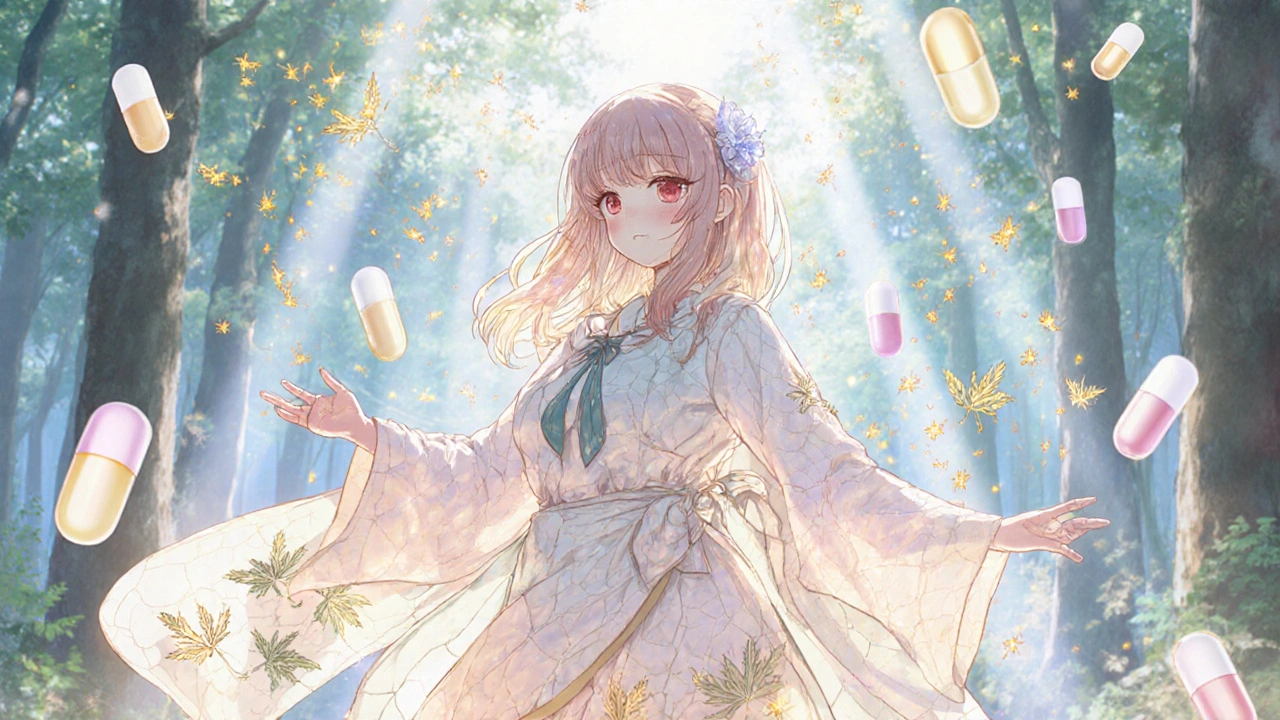
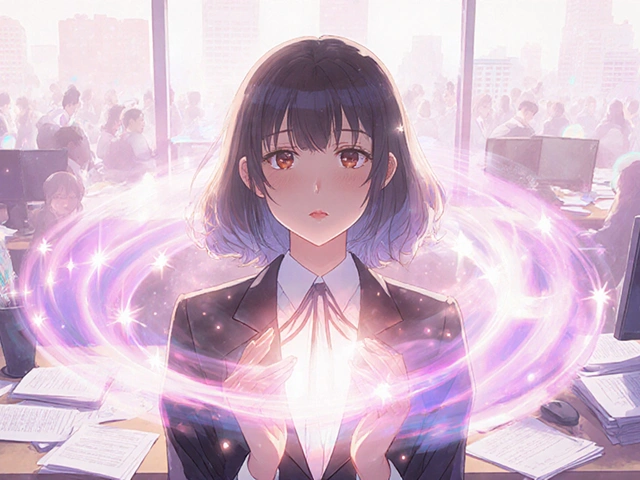
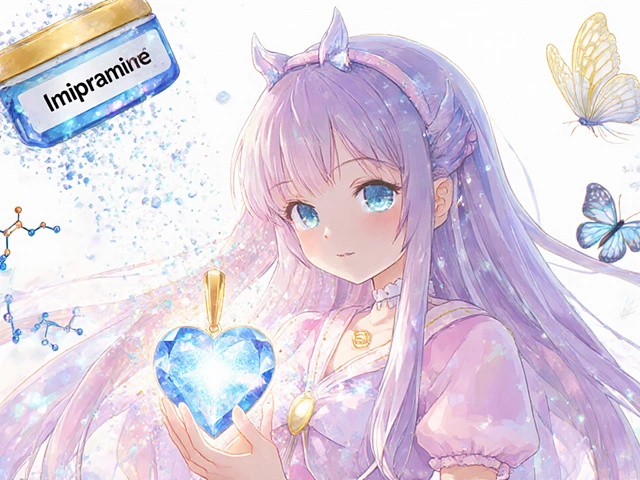
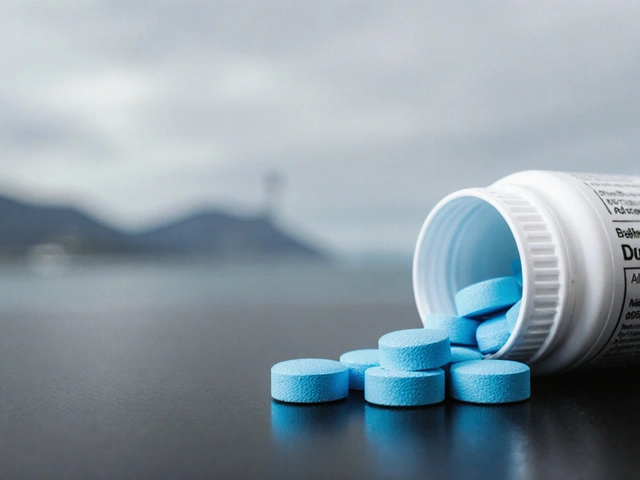


Comments
Dana Dolan
November 19, 2025 AT 05:02 AMMy niece was on this for 8 months last year - her skin went from cracked and bleeding to almost normal. But wow, the dryness? Her lips looked like sandpaper. We went through 3 tubes of ointment a week. Also, she got nosebleeds every Tuesday like clockwork. Still worth it, though. She finally stopped hiding in hoodies.
Richard Risemberg
November 20, 2025 AT 02:14 AMMan, this post is a godsend. I’ve been Googling ‘is acitretin gonna turn my kid into a lizard?’ for weeks. The breakdown on bone plates? Eye-opening. I thought it was just ‘dry skin and you’re good.’ Turns out it’s like giving a 10-year-old a nuclear-powered moisturizer. Low dose, short term, and watch those triglycerides like a hawk. Also - SPF 50 isn’t optional, it’s a survival tactic. Sunscreen is now part of our bedtime routine.
Andrew Montandon
November 21, 2025 AT 23:12 PMLet me just say - if your doctor hands you this pill without a 20-minute safety lecture and a signed waiver, find a new doctor. Seriously. This isn’t Advil. It’s a chemical scalpel. My cousin’s kid was on it for 5 months - monthly labs, growth charts, eye checks, triglyceride spikes, and we had to switch her to biologics because her ALT started creeping up. But here’s the kicker: she’s now in middle school without a single flare-up. It’s not magic. It’s medicine. And it demands respect.
Sam Reicks
November 22, 2025 AT 22:14 PMacitretin is just a gateway drug to big pharma control. they want you dependent. the bone thing? total scare tactic. look at the studies - funded by dermatology associations. and why do they say 3 years for pregnancy? because they dont want teens having sex. its all about control. my cousin took it and grew 6 inches taller. so yeah. fake dangers. real profits
Chuck Coffer
November 23, 2025 AT 11:32 AMWow. Someone actually wrote a responsible, well-researched piece about pediatric dermatology? Shocking. I thought this subreddit was just people asking if they can treat eczema with coconut oil and affirmations. You’re either a doctor or a very well-read parent. Either way - bravo. The rest of us are just here trying not to cry while applying 14 layers of emollient to our 7-year-old’s flaking legs.
Marjorie Antoniou
November 24, 2025 AT 18:04 PMMy daughter started acitretin at 11. We did everything right - monthly labs, sunscreen like it was her job, no vitamin A supplements. She had mild dryness, nosebleeds, one scary headache that turned out to be nothing. But the change in her confidence? Unbelievable. She started wearing tank tops. She laughed louder. I’d do it again in a heartbeat - if my doctor was this thorough. Don’t skip the follow-ups. They’re not bureaucracy. They’re lifelines.
Andrew Baggley
November 25, 2025 AT 00:35 AMLook - I get scared too. But if your kid’s skin is so bad they won’t hug you, or they cry before school because kids call them ‘scaly monster’ - then you do what you gotta do. Acitretin isn’t perfect. But neither is watching your child shrink into themselves. I’ve seen kids go from hiding to thriving in 6 months. Yeah, there’s risk. But the risk of doing nothing? That’s the real gamble. Don’t let fear make you passive. Be informed. Be vigilant. But don’t let the scary stuff paralyze you.
Frank Dahlmeyer
November 26, 2025 AT 23:23 PMLet me tell you about my nephew - 13 years old, ARCI, skin like cracked porcelain, couldn’t wear shorts, couldn’t swim, couldn’t sleep because the itching was relentless. We tried everything - from fish oil to wet wraps to cryotherapy (yes, really). Nothing worked. Then acitretin. Started at 0.4 mg/kg. Within 10 weeks, the cracks began to heal. By six months, he was wearing jeans again. He’s now in high school. Plays basketball. Doesn’t flinch when someone touches his arm. The side effects? Dry lips, yes. Nosebleeds, occasional. But the trade-off? He’s alive again. Not just surviving - living. And yes, we monitored like hawks. Blood tests every 28 days. Growth charts pinned to the fridge. No shortcuts. But the outcome? Worth every drop of sweat, every anxiety-ridden night.
Codie Wagers
November 27, 2025 AT 19:55 PMIt’s not about safety. It’s about surrender. We live in a world where we medicate childhood into compliance. Acitretin isn’t treating psoriasis - it’s treating the discomfort of watching your child be different. The bone changes? The triglycerides? The three-year pregnancy ban? These aren’t side effects. They’re symptoms of a system that demands perfection - and will chemically reshape a child’s body to achieve it. We call it medicine. I call it quiet violence. And we celebrate it as a triumph.
James Ó Nuanáin
November 28, 2025 AT 00:21 AMBrilliantly articulated, sir. One must admire the precision with which this article dismantles the myth of pharmaceutical benevolence. The mention of growth plate fusion is particularly poignant - a silent, irreversible alteration in the very architecture of a child’s future. One cannot help but reflect: in the pursuit of smooth skin, are we sacrificing the very essence of growth? And yet - the emotional relief for the family? Immense. A paradox wrapped in a capsule. I shall be forwarding this to my colleague at the Royal College of Dermatology. The British medical establishment must take note.
Nick Lesieur
November 29, 2025 AT 14:19 PMthis is why you dont trust doctors. my cousin took it and now his kid is 4 inches shorter than his twin. and the '3 year pregnancy ban'? lol. they just wanna sell more biologics. you know what fixes psoriasis? diet. no dairy. no sugar. done. acitretin? big pharma's latest money maker. dont be a lab rat.
Angela Gutschwager
November 29, 2025 AT 14:39 PMMy 12-year-old was on it for 5 months. Dry skin. Nosebleeds. Fine. But the triglycerides spiked to 480. We stopped. Now she’s on biologics. No growth issues. No liver stress. Just a monthly shot. This post is spot-on - but don’t let anyone make you feel guilty for choosing the safer path. Your kid’s future > their skin.
Andy Feltus
December 1, 2025 AT 12:29 PMHere’s the uncomfortable truth: we treat children like broken machines. We fix the skin, but we never ask why the skin broke in the first place. Is it genetics? Environment? Stress? Diet? Or are we just trying to make them look normal so we don’t have to look at our own discomfort with difference? Acitretin doesn’t cure psoriasis. It masks it. And maybe that’s enough - for now. But we owe our kids more than a chemical bandage.
Dion Hetemi
December 3, 2025 AT 00:45 AMLet’s cut the fluff. If you’re even considering acitretin, you’ve already lost. You didn’t try the right moisturizer. You didn’t find the right dermatologist. You didn’t go full keto. You didn’t eliminate gluten. You didn’t do the salt water baths. You didn’t meditate with your child. Now you’re on this? You’re not a parent. You’re a surrenderer. And now your kid’s liver is paying for your laziness.
Kara Binning
December 3, 2025 AT 12:51 PMI just want to say - as a mother of two with chronic skin conditions - I read this entire post with tears in my eyes. Not because I’m scared. But because someone finally got it. The sleepless nights. The shame. The way your child looks at you when they ask, ‘Mom, am I ugly?’ This isn’t just medicine. It’s dignity. And if acitretin gives that back - even for a year - then it’s not dangerous. It’s holy. I’ll never apologize for choosing my child’s peace over my fear.